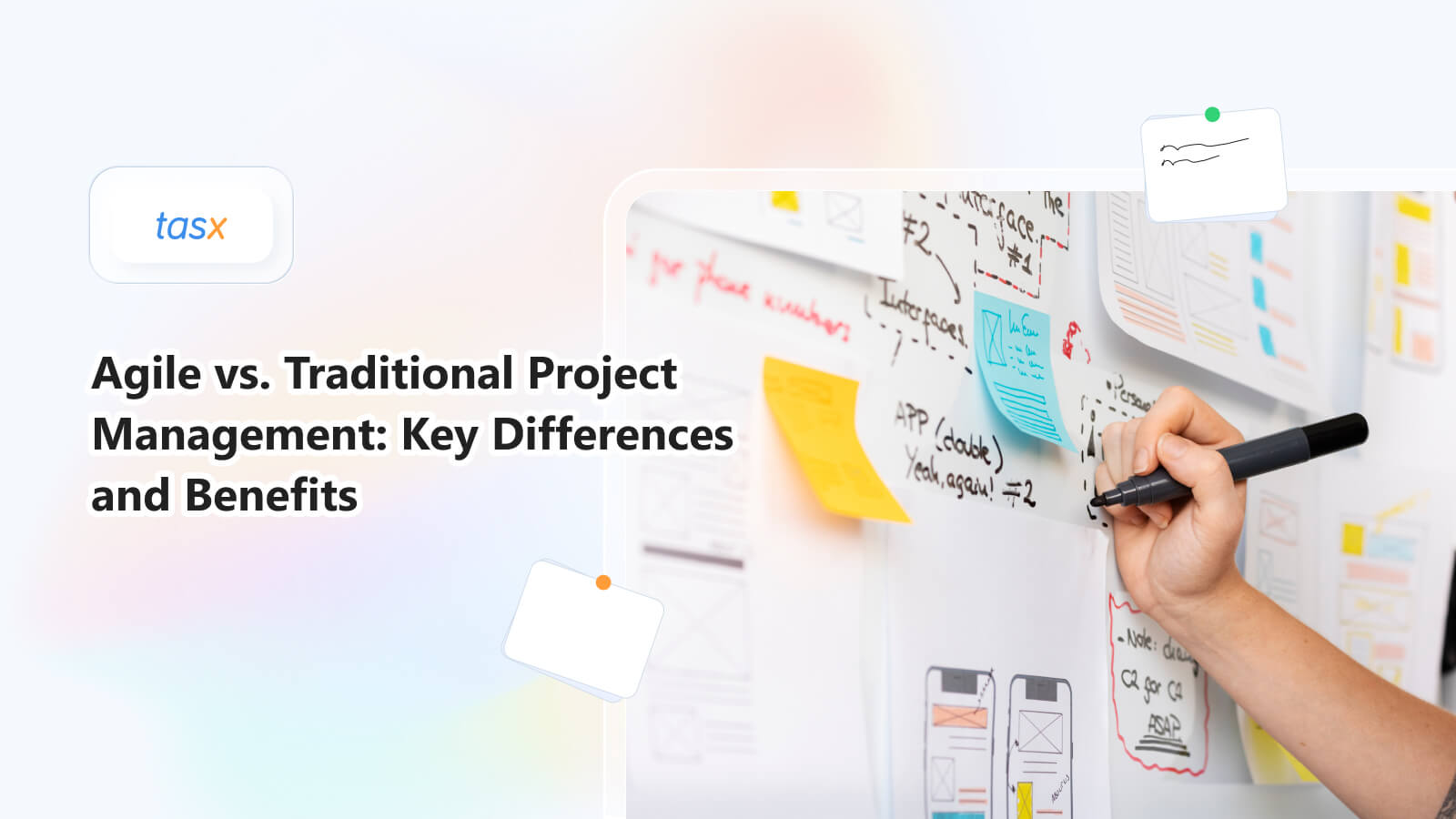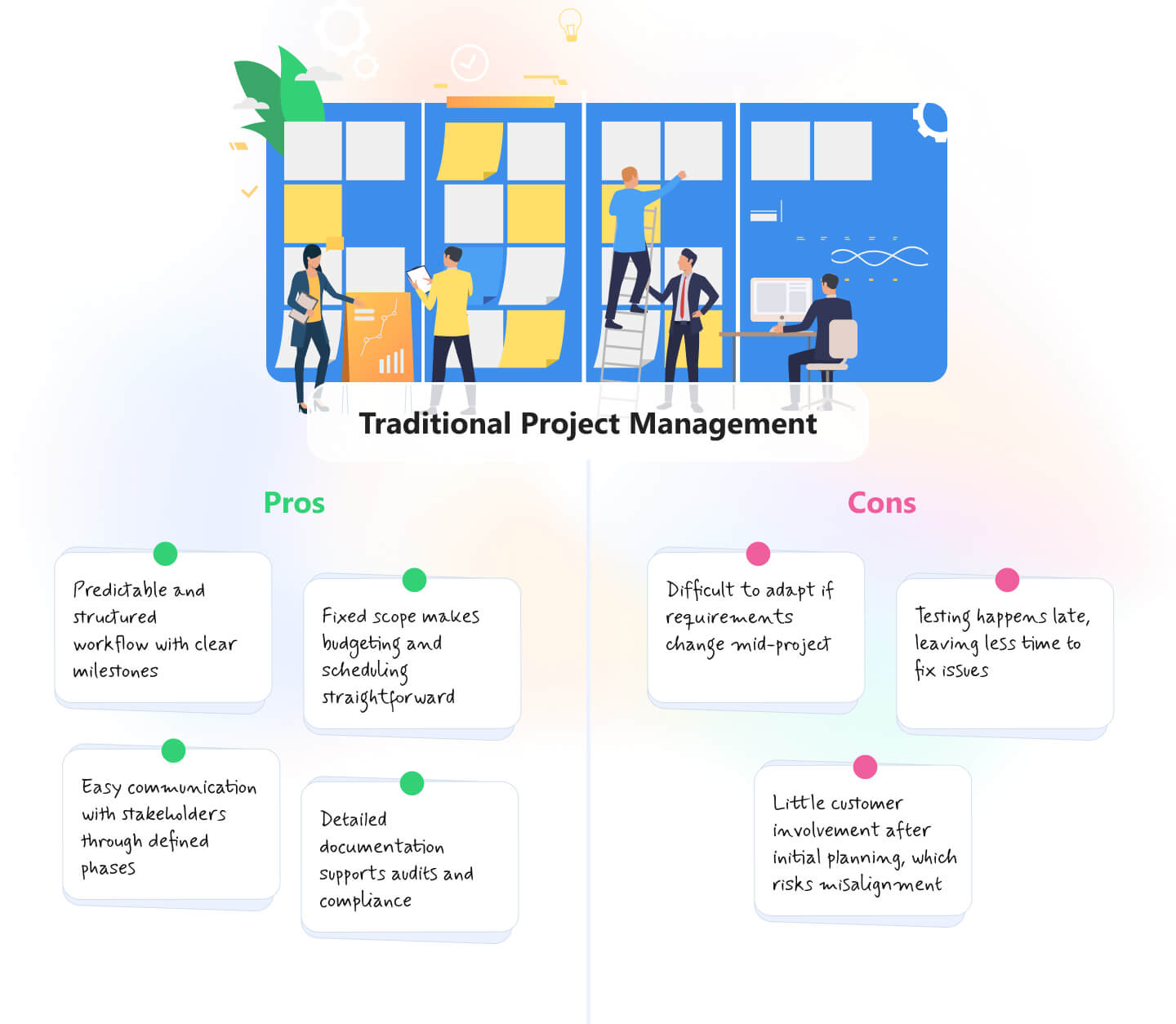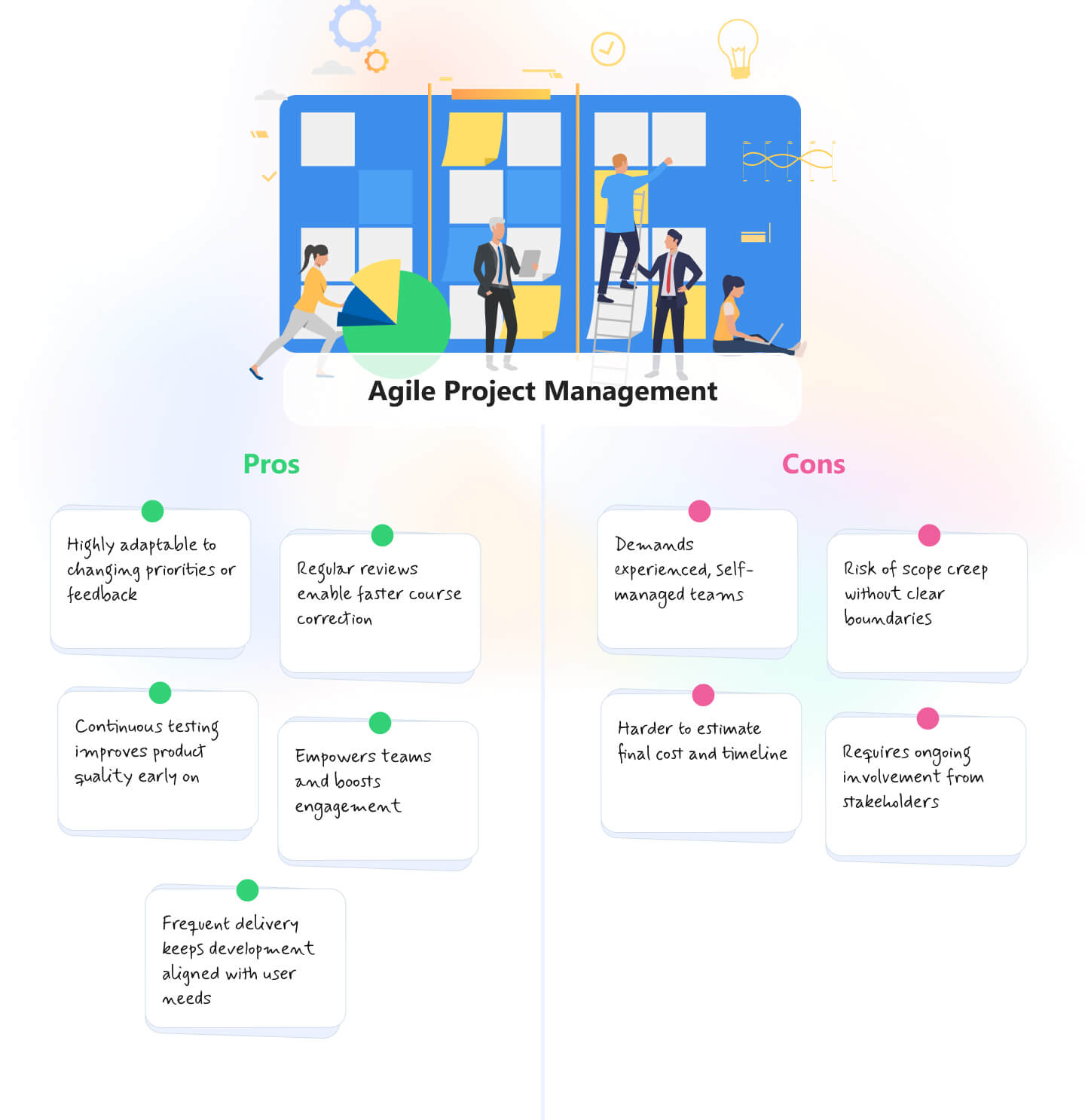
Project management is the structured process of planning, executing, and delivering work to achieve specific goals within defined constraints such as time, budget, and scope. It provides teams with the tools and frameworks needed to organize tasks, allocate resources, and ensure accountability throughout the project lifecycle.
Two of the most widely used project management methodologies are Traditional (Waterfall) and Agile. Traditional project management follows a linear, sequential approach, where each phase is completed before the next begins. In contrast, Agile promotes an iterative, flexible process that emphasizes collaboration, rapid delivery, and continuous improvement.
Choosing the right project management approach can significantly impact a team’s efficiency, adaptability, and overall project success. Understanding the differences between Agile and Traditional methods is crucial for selecting the framework that best fits your project’s needs, team dynamics, and business goals.
What Is Traditional Project Management?
Traditional project management, often referred to as the Waterfall model, is a linear and structured approach where the project is divided into distinct phases typically: Initiation, Planning, Execution, Monitoring, and Closure. Each phase must be completed before moving on to the next, with little room for revisiting earlier stages.
Core Principles
- Sequential process: Each step follows the previous one without overlap.
- Defined scope and requirements: Goals, timelines, and deliverables are established at the beginning.
- Heavy documentation: Detailed plans and reports guide the entire project lifecycle.
- Predictability: Progress is measured against a fixed schedule and budget.
Common Industries and Applications
Traditional project management is widely used in industries where:
- Requirements are well-understood and unlikely to change
- Compliance and risk management are critical
Examples include:
- Construction and architecture
- Manufacturing
- Aerospace and defense
- Government and public sector projects
Example of a Traditional Project Flow
Imagine a construction project:
- Initiation: The client defines the purpose and scope.
- Planning: Engineers and architects create blueprints and schedules.
- Execution: Contractors begin building according to the plan.
- Monitoring: Inspectors ensure each stage meets standards and timelines.
- Closure: Final checks are completed, and the project is handed over.
This structured flow ensures predictability and control, making it suitable for projects with fixed requirements and clear outcomes.
What Is Agile Project Management?
Agile project management is a flexible, iterative approach to managing projects, especially in environments where change is frequent and requirements are expected to evolve. Unlike traditional methods that follow a fixed sequence of stages, Agile encourages adaptive planning, continuous improvement, and early delivery of value through small, manageable work segments.
Originally rooted in software development, Agile has since been embraced by a wide range of industries from marketing and product design to education and construction thanks to its collaborative nature and focus on customer satisfaction.
Core Principles of Agile
Agile is guided by the Agile Manifesto, which emphasizes:
- Individuals and interactions over processes and tools
- Working solutions over comprehensive documentation
- Customer collaboration over contract negotiation
- Responding to change over following a plan
From these values come several key principles:
- Iterative development: Projects are broken into short cycles (usually 1–4 weeks) called sprints or iterations, each producing a potentially shippable product increment.
- Customer involvement: Stakeholders are engaged throughout the process to provide feedback and reprioritize work based on evolving needs.
- Team empowerment: Agile teams are self-organizing and cross-functional, with shared ownership of outcomes.
- Embracing change: Changes to scope or features are not only tolerated but welcomed if they improve the end product.
Popular Agile Frameworks
Agile is an umbrella term that encompasses several frameworks and methodologies, each with its own structure and terminology:
Scrum: The most popular Agile framework. It uses sprints, daily stand-ups, product backlogs, sprint reviews, and retrospectives to drive progress and continuous improvement.
Kanban: Focuses on visualizing work through task boards, limiting work in progress (WIP), and improving flow and efficiency over time.
Lean: Draws from Lean manufacturing principles to eliminate waste, amplify learning, and deliver quickly.
Extreme Programming (XP): A development-specific method that focuses on technical excellence, continuous integration, test-driven development, and close collaboration.
SAFe (Scaled Agile Framework): Designed to implement Agile practices across large, enterprise-level organizations.
Example of an Agile Workflow
Let’s say a product team is building a new e-commerce feature, like a personalized product recommendation engine:
- Backlog Creation: The product owner gathers input from users and stakeholders, translating needs into user stories stored in a product backlog.
- Sprint Planning: The team selects a set of user stories to complete in a 2-week sprint, ensuring they are clear, estimated, and prioritized.
- Daily Stand-ups: Each day, team members briefly share progress, blockers, and plans for the day to stay aligned and address issues early.
- Sprint Execution: Designers, developers, and QA collaborate to build and test the feature incrementally.
- Sprint Review: At the end of the sprint, the team demonstrates what they’ve built and collects stakeholder feedback.
- Retrospective: The team reflects on what went well, what didn’t, and what to improve in the next sprint.
This cycle repeats, allowing the team to deliver value continuously, pivot as needed, and refine the product based on real user feedback—without waiting until the end of the project to evaluate success.
Key Differences Between Agile and Traditional Approaches
While both Agile and Traditional project management aim to deliver successful outcomes, they take fundamentally different paths to get there. Understanding these differences is essential when deciding which methodology fits your project best. Below is a side-by-side comparison of the core aspects that set them apart:
| Aspect | Traditional Project Management | Agile Project Management |
| Project Planning | Detailed upfront planning with fixed scope, time, and cost. | High-level planning at the start; detailed planning evolves during the project. |
| Flexibility & Change Management | Resistant to changes; changes are costly and discouraged mid-project. | Highly flexible; welcomes and adapts to changing requirements at any stage. |
| Team Collaboration | Roles are clearly defined and hierarchical; teams work in silos. | Cross-functional, self-organizing teams with shared responsibility. |
| Customer Involvement | Limited to early requirements and final delivery stages. | Continuous involvement; feedback is integrated throughout the process. |
| Timeline & Delivery | Delivery happens at the end of the project. | Work is delivered in short, frequent iterations (sprints). |
| Risk Management | Risks are identified and addressed mostly during planning. | Risks are managed continuously through feedback and iteration. |
Pros and Cons of Each Methodology
Choosing between Agile and Traditional project management is not just about preference it’s about aligning the method with the type of project, the team’s workflow, and how much uncertainty or change you’re expecting. Below is a deeper look into the advantages and trade-offs of each approach.

Traditional Project Management (Waterfall)
This methodology is best suited for projects with a clear beginning, middle, and end—where requirements are unlikely to change and where predictability is crucial.
Pros:
- Predictable and structured: Because all phases are planned in advance, it’s easier to set expectations, define milestones, and measure progress.
- Straightforward budgeting and scheduling: With a fixed scope and timeline, resource planning is simple and well-documented.
- Easy stakeholder communication: Progress reports are tied to clear stages, making it easy for external stakeholders to understand what’s happening.
- Strong documentation: Every stage is documented, which is helpful for compliance, audits, or future reference.
Cons:
- Inflexible to change: If requirements shift mid-project, adapting can be costly and time-consuming, often requiring formal change requests.
- Delayed testing and feedback: In many Waterfall projects, testing is done only at the end leaving less time to fix major issues.
- Limited customer input after kickoff: Once requirements are defined, the customer may have little involvement until delivery, increasing the risk of misalignment.
This method works well for projects like infrastructure, hardware development, or compliance-heavy initiatives where stability is more important than speed or adaptability.

Agile Project Management
Agile shines in dynamic, fast-paced environments where collaboration, responsiveness, and ongoing user feedback are key to success particularly in software development and product innovation.
Pros:
- High adaptability: Teams can pivot quickly when priorities shift or new information becomes available, without disrupting the whole project.
- Faster feedback loops: Regular demos and reviews mean stakeholders can see progress early and suggest course corrections.
- Improved product quality: Continuous testing and iteration lead to early detection of bugs and better alignment with user needs.
- Greater team engagement: Agile empowers team members to take ownership of outcomes, often leading to higher morale and productivity.
- User-focused development: Frequent delivery of working features ensures that what’s built is genuinely useful to customers.
Cons:
- Requires experienced teams: Agile demands a level of self-organization, discipline, and communication that may be challenging for less mature teams.
- Potential for scope creep: Without strict boundaries, the project can evolve beyond the original vision, impacting budget and deadlines.
- Uncertainty in budgeting and timelines: Since the full scope is not fixed up front, it can be harder to predict total costs and timeframes.
- Requires continuous customer involvement: Stakeholders need to be available regularly, which can be difficult in some organizations.
Agile is ideal for projects where learning through iteration is part of the process especially when market conditions or customer expectations evolve quickly.
When to Use Agile vs. Traditional Project Management
Selecting the appropriate project management methodology is a strategic decision that can significantly influence a project’s success. Each approach offers unique strengths and is best suited to specific types of work environments, risk profiles, and business goals.
When to Use Agile
Agile is ideal for dynamic, fast-paced projects where flexibility, speed, and continuous stakeholder involvement are essential. It works particularly well when final requirements are not fully known at the outset or are expected to evolve over time.
Agile is a strong fit for:
- Product development and innovation where user feedback drives iteration
- Technology and software projects that benefit from incremental releases
- Startups and growing businesses that need to pivot quickly
- Creative industries like design, marketing, and media production
- Cross-functional teams working closely and collaboratively
Organizations that adopt Agile typically value rapid delivery, adaptability, and high user involvement throughout the project lifecycle.
When to Use Traditional (Waterfall)
Traditional project management is best suited for projects with clearly defined goals, fixed requirements, and little expected change. Its structured, phase-based approach allows for detailed planning, risk assessment, and progress tracking from the beginning.
Traditional is well-suited for:
- Construction, engineering, and manufacturing where processes are sequential
- Government and public sector projects with strict compliance requirements
- Projects with high risk or safety concerns, such as aerospace or defense
- Large-scale infrastructure and procurement initiatives with fixed contracts
- Environments that require extensive documentation and formal approval processes
This approach provides predictability, control, and accountability, making it ideal for industries where change is minimal and scope must remain consistent.
Considering a Hybrid Approach
In many real-world scenarios, neither Agile nor Traditional methods alone fully address a project’s complexity. A hybrid approach, often referred to as “Agile-Waterfall” or “Water-Scrum-Fall,” combines the rigorous planning and structure of Traditional PM with the flexibility and iterative delivery of Agile.
A hybrid model is effective when:
- Strategic planning and governance are required, but day-to-day execution needs agility
- Regulatory or compliance phases must follow strict guidelines, but development work benefits from iteration
- Multiple teams across departments or vendors need to align under a unified framework
By blending methodologies, organizations can adapt to uncertainty while maintaining oversight and structure, especially valuable in enterprise environments with both innovation-driven and compliance-bound initiatives.
Conclusion
Both Agile and Traditional project management methodologies have their strengths, and choosing the right one depends on the nature of your project, team dynamics, and business goals. Agile offers flexibility and rapid iteration, while Traditional methods provide structure and predictability. In many cases, a hybrid approach can offer the best of both worlds.
Ultimately, the most effective methodology is the one that enables your team to deliver value consistently and adapt to change with confidence.
If you’re looking for a platform that supports both Agile and Traditional workflows, with powerful task management, collaboration features, and real-time visibility across teams Tasx can help. Whether you’re running sprints or managing long-term initiatives, Tasx gives you the tools to stay organized, aligned, and focused on results.
Start simplifying your workflow today with tasx.com.



